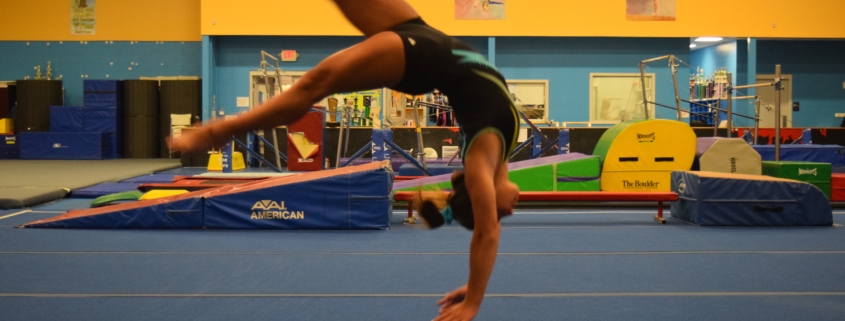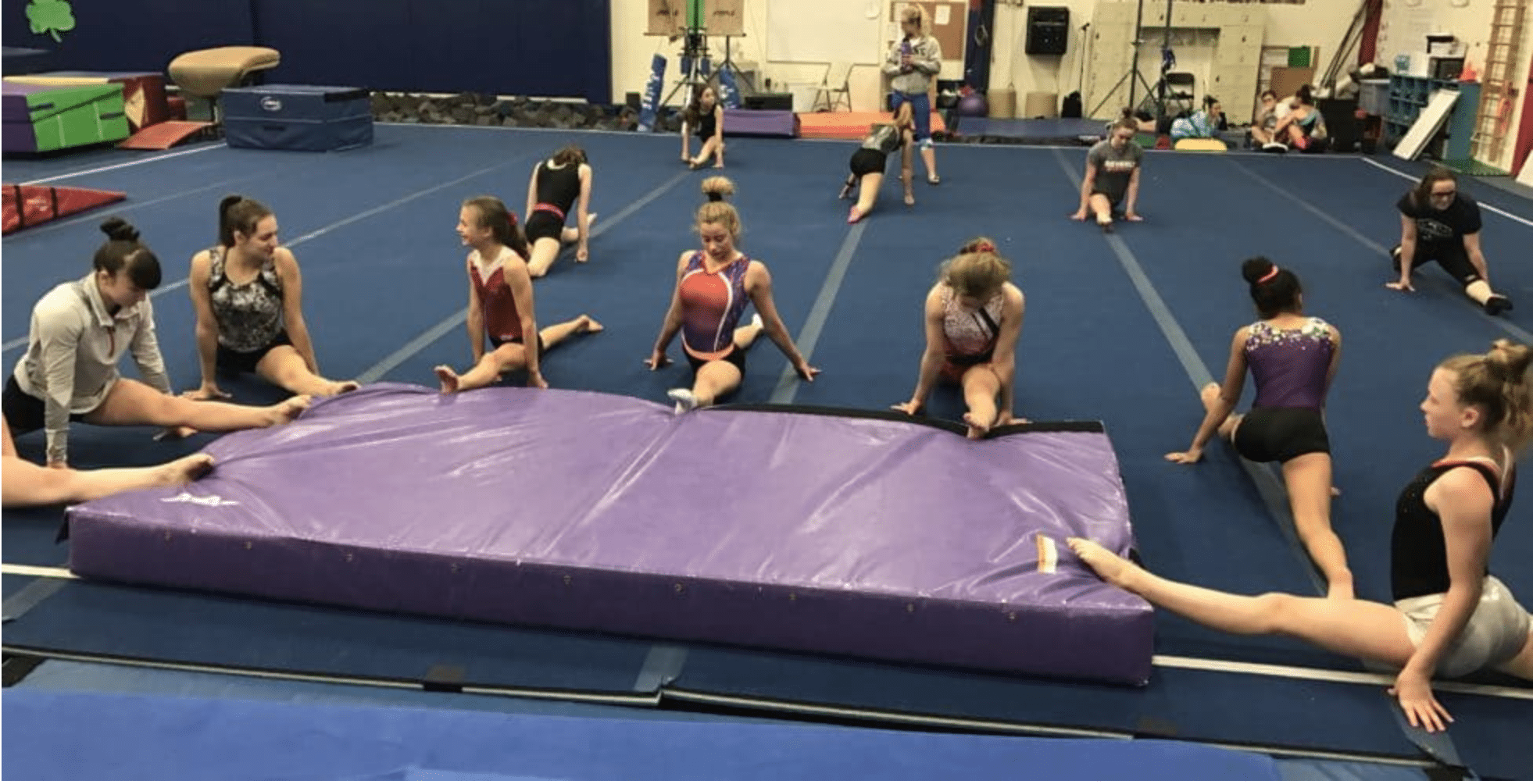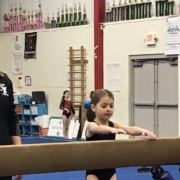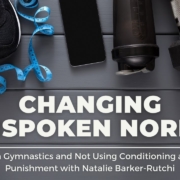7 Culture Changes Gymnastics Needs for The Future
In the first few years of starting SHIFT, the most common questions I got from email or social media surrounded flexibility, injuries, physical preparation, or skills.
In the last two years, one new question has replaced these in the number one spot. I would argue it’s been more common than all of those other categories put together.
The question is –
Table of Contents
“How do we change the culture of gymnastics so that athletes are happy, healthy, and high performing“
Over the last few years, controversy, scandal, and some terrifying displays of human nature have been revealed in gymnastics. The curtain has been pulled back on many of the dark corners in gymnastics people did not know existed. I was fortunate to have an amazing coach and environment both growing up and competing in college. It was incredibly tough, but my mentors always placed my health and well being above winning medals or competing new skills.
When news of these scandals surfaced, I was equal parts heartbroken, infuriated, and motivated to work for new training solutions. I actually ended up canceling future speaking events, deleting all my social media, and focusing exclusively on researching/writing a 16 chapter e-book for 8 months.
I released it for free last year under the title “Changing Gymnastics Culture: Reflections, Lessons, and Visions for the Future” (you can download the full book of individual chapters for free here – https://shiftmovementscience.com/freeresourcelibrary/ ).
I did this because I believe in gymnastics. I believe in the people through our community worldwide. I believe in its ability to teach values like work ethic, perseverance, mastering fear, and the benefits of communities. Most importantly, I also believe in everyone working together to build a better version of gymnastics for the future. One that has a significantly different approach than what we have done for the last 20 years.
All of Gymnastics is Not Broken, But We Have A Massive Amount of Work To Do
.
I have spent 25 years in gymnastics as an athlete, coach, and for the last 5 years as a Sports Physical Therapist and researcher. I have been very fortunate to travel the world through my company, SHIFT, working with thousands of gymnasts and gymnastics professionals. I still actively coach gymnasts and as work a medical provider providing services to 20-30 gymnasts per week at our clinic, Champion Physical Therapy and Performance, in Boston.
Through these experiences and my own time as an athlete, I can tell you that there are many examples of incredible coaches, parents, medical providers, and facilities that are shining examples of the benefits gymnastics can give kids when implemented properly. The leaders in these communities have amazing moral fabric, discuss issues openly, and truly care for their athlete’s mental/physical health. Above all, they have a phenomenal balance of mastering their own craft while also continuously seeking out new information or professionals to learn from in a growth mindset.
This being said, the harsh reality is that the type of leadership, environment, and culture mentioned above is not universal as it should be. There are far too many training environments that have leaders who use fear or judgment based motivation strategies, use training techniques that lack the best scientific or expert coaching opinion, and have questionable moral judgment when it comes to putting extrinsic things like status, money, or social media attention ahead of athlete health. Either due to ego or lacking work ethic, they chose to not seek new education or working with other professionals on ways to improve.
It is sad to see, mainly because athletes suffer most, both in performance and health. But I will be honest in saying that as a younger coach who came through a very traditional model of learning how to work in gymnastics, I made all of these mistakes and suffered the consequences first hand.
I was guilty of many of these problems, having a toxic mix of ego and delusion that lead to a rough reality check. The athletes I coached resented me, injury rates were staggeringly high (and I just blamed it on “Gymnastics being hard”), and athletes/coaches/parents alike were burnout out and frustrated. A main drive of starting my company in 2013 was to help people not make the mistakes I did, and share what I was learning with people as I went.
I’m not naive to know that sometimes these problems do boil down to gymnasts who don’t want to work hard or may not take corrections well, parents who are out a bit out of touch, the reality of working with emotional kids, and gymnastics being an incredibly tough sport that comes with accidental injuries. However, in my opinion, these are most often a smaller piece of the puzzle behind why many training environments suffer.
7 Tips on Changing Gymnastics Culture Worldwide
.
Thankfully through a lot of work, patience, and collaboration, over the last 5 years both myself, the gym I am a part of, and other training gyms I have been fortunate to consult with, have been able to make very positive trends upwards in culture. We still have the normal issues most gyms do with unintended injuries popping up, having to work with kids, and coaching conflicts, but it is nothing like the more traditional environment we had when I first started 5 years ago.
I was recently asked by someone on social media the “how do we change gymnastics culture” question again. I thought it would be a good time to share 7 general tips for people moving forward based on my experiences. These come from studing many highly succesful, and high performing gymnastics cultures, but also seeing some examples that need improvement.
These are just my general observations from all my time in gymnastics, and also what I have seen during my travels or work with many gymnasts.
1. Everyone Taking On More Accountability and Self Awareness
By far, the number one thing I think every person in gymnastics needs to do is take a hard look in the mirror. Obviously, there are people in gymnastics who have shown they have terrible judgment and moral fabric, and they should rightfully be held accountable for their actions. Outside of this group, the other 95% of gymnastics professionals should really sit with themselves to ask questions like
“Why am I involved in gymnastics?”
“What are my foundational motivations, values, and morals?”
“Am I doing all that I can to be a positive role model and serve my athletes well?”
We all need to hold ourselves accountable to make sure that we are very clear about our reasons for being involved in gymnastics, as well as examining the training techniques and approaches we use every day.
We must do everything in our power to be educated about new ideas, make sure we are radically transparent in our environments, that we are using healthy communication/motivation techniques, and that we are actively seeking to do the best we possibly can in our own gyms. This requires a huge amount of self-awareness and humility, and some tough conversations with yourself or others, but I feel without this the culture of gymnastics will continue to be problematic.
2. Eliminate the Say-Do Gap
On the foundation of number one, the easiest way to break trust with gymnasts or colleagues is to have a gap between what you do and what you say.
It doesn’t matter if you are a coach, medical provider, support staff, or parent. If you say that health and wellness are the priority, but then do not take care of your own health or take the time to collaborate with medical providers about an injury, those example speak for themselves. In the same light, if you say communication is important, but get defensive every time someone offers you constructive criticism, nonverbal communication and your habits replace any words you try to use.
In the opposite light, the positive examples shine through. If you say you want to use the latest training techniques supported by science or expert coaching opinion, and then display that by studying 2 hours per day and trying new ideas, it will also represent itself. If you preach self-control and temperance with your athletes and then do not lose your temper to yell during training when you get frustrated, that is massively influential to the people in your environment.
If you are unhappy with your role in gymnastics or the culture you work in, start with accountability and quietly leading by example. Will some people not do the same? Most definitely. But you can’t control them. You can only control yourself.
3. Pushing Athletes Hard But Intelligently
There is a growing body of evidence in the sports performance world that outlines how tough training may be beneficial to enhance performance and reduce the risk of injury (one research example here). A very important caveat here is that most research is done with adults, not 7-17-year old kids.
The other important note is that this must be done by slowly stressing athletes in the right dosage, and then following that with the proper time interval and environment for recovery. With new research discussing 48 – 72 hour of recovery between tough gymnastics sessions (find that research here), it raises some thoughts about how we plan or dose gymnastics workouts.
Contrary to what many people may think, I am actually very in favor of hard but intelligent training. It was one of the foundations to my progress in gymnastics, both mentally and physically. It’s something I promote in the gymnasts I coach or work with for medical injuries, and it’s something that I teach to anyone around the world.
However, tough training is not just what will make gymnasts sweaty and tired. And recovery does not just mean a cool down stretch or 5 minutes of foam rolling really fast at the end of practice. The training strategies we use must extremely well be researched, implemented, monitored, and refelcted upon constantly.
If gymnastics cultures really wish to change, the people inside of them will do the work to spend hours studying the latest science in these topics and use open communication to make sure they are training both hard and smart.
4. Collaborate, and Give Everyone and Equal Voice in Training Decisions
The current culture in gymnastics almost always has a gymnastics coach being the ring leader for all decisions, involving parents in the process as needed. I feel this is an extremely flawed model. For most well-intentioned coaches, it simply just places way too much responsibility on them to teach skills, know everything about strength and conditioning, be a mental health consultant, understand injuries, also know about nutrition, and more. It’s an impossible task, and almost always leads to burnout.
For coaches who are unfortunately on a power trip, it gives them a dangerous pedestal to call the shots without proper checks and balances from other adults. It becomes not only an impossible task, but an incredibly toxic and dangerous one.
I firmly believe that the future of gymnastics will need interdisciplinary models of care, where multiple professionals are working together around the gymnast in the center of the model.
And the most important voice in all of this which usually is considered last? The gymnast. Even though they are often times kids, they are the ones doing gymnastics, dealing with fear, and working through aches or pains. If you can not actively involve them to make a decision, it’s not going to go well. It’s simple, but not easy. But it’s necessary.
5. Critique Athlete Behavior, Not The Athlete
I learned this from my incredible boss and friend, Eva Shute, early on in working at our gym. After one particularly frustrating practice where our gymnasts spent five times in the chalk bucket talking than actually doing gymnastics, her and I had a good chat after practice.
She pointed out to me that although it’s not intentional, many times coaches phrase their comments in critiquing the athlete themselves, not the athlete’s behaviors. This starts a vicious cycle of self-defensive posturing and disengagement. There is a huge difference there, especially when it comes to building a professional coaching relationship with trust.
We should strive to not attack who a gymnast is, but rather the choices they make or behavior they display. Telling a gymnast
“Your behavior right now of choosing to spend 5 minutes talking in the chalk bucket instead of doing drills is not in line with the expectations we agreed upon for our gym. We need to adjust this, or we will have a different conversation about being here with the group who is trying to get stuff done”
is very different than
“You are lazy because you are spending 5-minutes talking in the chalk bucket instead of doing drills. Fix it or you can leave.”
We need to really think about our communication skills. There are many times our athletes certainly need to be held accountable for what they do, but that is by no means an excuse to berate them as a person. If this exists in a culture, it needs to change immediately if it has hope for the future.
6. Don’t Value The Opinion Someone Has of You More Than Your Opinion of Yourself
This is more on the personal development side but was huge for me after studying some of Gary Vaynerchucks content. Many people, unfortunately, value someone else’s opinion of them more than their own opinion of themselves.
Other peoples judgment becomes their main motivation source, and it leads to a ton of unhappiness and poor decisions being made. Ironically enough, a gymnast of mine brought this quote up to use in one of our weekly “whiteboard sessions” and it hit the nail on the head.
“Can you remember who you were, before the world told you who you should be?”
.
In gymnastics culture, I often see this manifest as competing new skills too soon because people want to get validation from other coaches, parents, gymnasts, or social media. I also see it as people not embracing the reality of an injury because they are scared of what people will say about their coaching style or training methods. There are many more examples past this.
My best advice goes back to number one, and is what I’ve seen in successful coaches or training gyms. First, make sure you are acting as a good human. Then, align your habits with your values, block out the noise of negative people, and do the best by gymnasts you work with every day. If you can go to sleep at night knowing you did the best you can with what you have, slowly but surely your example will help change the culture for the better.
7. Don’t Be Afraid of Very New, and Very Different, Ideas
This last thought I put at the end of the list on purpose. Gymnastics is changing, fast. Due to equipment advances, harder skills being competing at younger ages, and the massive surge of new research-based science or expert gymnastics coaching opinion spreading through the internet, our training approaches are rapidly being adjusted. It can be incredibly overwhelming.
When you place these things on the backbone of exposure of the scandals and frightening examples of what can go wrong when we don’t use the best methods, huge change is inevitable.
Productive change is a very good thing.
But, you can’t be afraid of radically new ideas or concepts. If you are worried about looking bad in front of your gymnasts or coaches because you didn’t know something, re-reading number 6. Realistically, the people around you will probably be impressed by your ability to humbly admit fault and own up to it, followed by you being open to learning more.
You can’t be afraid of using these new things, not having them pan out perfectly, and then needing to adjust and start over with the new knowledge gained. This is the mandatory cycle of high performance and great cultures.
I predict the biggest changes will come through the concepts above along with hybrid strength and conditioning models that use both weight lifting and body weight training, the use of periodization more formally, updated flexibility approaches, delayed ages of high-level competition with later “peak” ages, more interdisciplinary team-based models for helping athletes, and new medical management/training techniques based on blended science and coaching opinion.
I know that was a long one, but I really wanted to make sure I fully outlined my thoughts and rationales. I hope you found it helpful, and if you did I would really appreciate you share it with your gymnastics community. Have a great week!
Dave
Dr. Dave Tilley DPT, SCS, CSCS
CEO/Founder of SHIFT Movement Science









